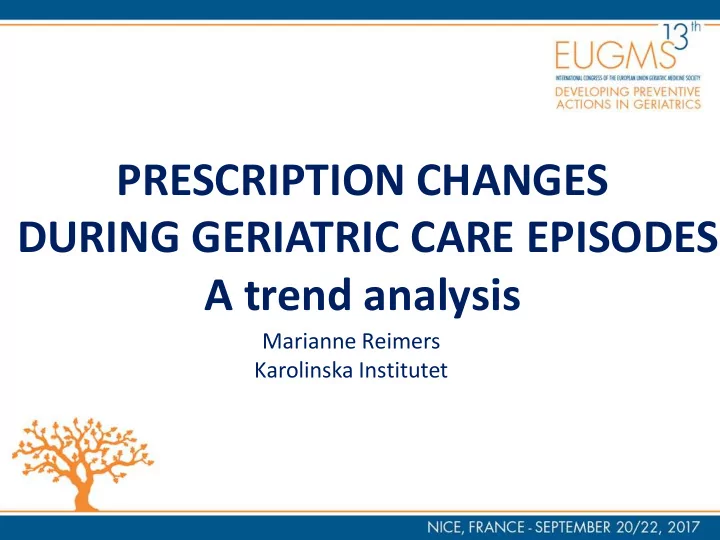

PRESCRIPTION CHANGES DURING GERIATRIC CARE EPISODES A trend analysis Marianne Reimers Karolinska Institutet
• 2005, 2010, 2015 • Prescription changes during care episodes and over time • Factors potentially contributing to such changes
What does a geriatrician do? • ” Terminates all drug treatment ”? • ” Inserts too many additional drugs ”? • ” Optimizes drug treatment for every individual ”?
Crucial issues • Differences between prescribed drugs at admission and discharge • Improvements? During the care episode – over the years? • How do we measure this? • What determines such differences? – Comorbidity? Age? Sex? Number of drugs? Length of care episodes?
Warranted: Outcome measure(s)!? • Relation to guidelines? – not appropriate • Relation to quality indicators of the Swedish National Board of Health and Welfare? – not appropriate • Number of drugs? – not appropriate • Prescription changes? – such as at discharge remaining changes of regularily used drugs
Prescription changes • Positive – Sign of expressed ambition – Sign of expressed activity – Indicating enhanced sensitivity • Negative – Not yet validated
Corroborating prescription changes as outcome measure by the use of IDU-index • IDU (inappropriate drug use) index based on six indicators from the Swedish National Board of Health and Welfare: – Longacting bensodiazepines – Moore than three psychotropic drugs – Drug doubling – Anticholinergic drugs – C-interactions – D-interactions
Correlation prescription changes - IDU-index Correlation with prescription changes Coefficient SD p-value 95% KI 0.171 – 0.969 Change in IDU-index 0.570 0.203 0.005*
Warranted: the archetypical geriatric patient • Diagnostic choice pneumonia – Justification: • prevalent, wide range of older individuals • Inclusion criteria – All patients with main diagnosis pneumonia in one geriatric clinic in Stockholm – Pneumonia related treatment excluded
The patients Year of inclusion 2005 2010 2015 n 146 134 140 Age, years, mean 84,3 85,2 84,0 Proportion females, % 54,8 53,0 57,1 Comorbidity, Charlson 1,9 2,2 2,4
12,2 10,8 9,9 8,8 8,8 8,3 7,9 6,4 6,3 2,13 1,88 1,1 LENGTH OF CARE EPISODES NUMBER OF DRUGS AT NUMBER OF DRUGS AT NUMBER OF PRESCRIPTION ADMISSION DISCHARGE CHANGES 2005 2010 2015
0,7 0,66 0,57 0,5 0,49 0,41 0,04 -0,01 2005 2010 2015 -0,16 IDU-INDEX AT ADMISSION IDU-INDEX AT DISCHARGE IDU-INDEX CHANGE DURING THE CARE EPISODE
Changes 2005, 2010, 2015 • Increased number of comorbidities • Increased number of drugs at admission and discharge • Shorter care episodes • Fewer prescription changes
Changes during a geriatric care episode • Improvement 2005 and 2010 assessed by the IDU-index • Detoriation 2015 assessed by the IDU-index
Regression analysis: 1 factor • Age – NO • Sex – NO • Number of drugs at admission – NO • Comorbidity – 2015 YES, totally – NO • Length of care episode – YES
Correlation between prescription changes and length of care episodes Correlation with prescription changes Coefficient SD p-value 95% KI Length of care episode 0.073 0.012 0.000* 0.050 – 0.097
Shorter length of care episode, fewer drug changes – but decreasing quality?
Acknowledgement • Professor Maria Eriksdotter, Karolinska Institutet • Professor Åke Seiger, Karolinska Institutet • Professor Johan Fastbom, Karolinska Institutet • Stockholms Sjukhem Foundation
CONFLICT OF INTEREST DISCLOSURE I have no potential conflict of interest to report
Recommend
More recommend